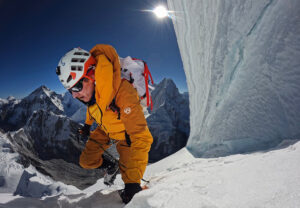At 67, Mick Fowler is far from slowing down. In fact, he has more time to climb now that he is retired. In July, he teamed up with fellow British climber Simon Yates for an attempt on the north face of Patkhor, a 6,083m peak in Tajikistan.
It was Fowler’s idea, says Yates, who admitted that Patkhor intrigued him. “[It] was similar to some of the objectives I’ve picked myself over the years,” Yates told ExplorersWeb. “A good-looking technical unclimbed line on an attractive 6,000m peak. Also, I’d not been to that group of mountains in Tajikistan before.”
Back at home, Fowler summarized the trip highlights:
Memories this year include poisoning ourselves on freeze-dried food, discovering much of our remaining food had gone off, reduced rations for four days, no food for six days, deep whiteout snow, no summit, a difficult retreat, a broken Abalakov screw, a failed abseil anchor, five broken ribs and two crushed vertebrae for Simon, much lost kit, two shelterless nights, one shared sleeping bag…and a painful walk-out assisted by a Tajikistan rescue team.
We contacted Simon Yates to find out more.
The Rushan Pamir
Yates, 60, and Fowler, 67, wanted to complete an ascent of the north face of Patkhor, in the Gorno-Badakhshan region of Tajikistan. The plan was to climb a new route and then traverse the mountain, descending the south face.
Patkhor is the highest peak in the Rushan Pamir. It was first climbed by a Russian team, including famed Soviet climber Evgeny Abalakov, via the west ridge in 1946. A six-man Leningrad team led by Oleg Kapitanov first climbed north face route in 1975, following a line between two huge ice cliffs. For this, they won a technical climbing award in the then-USSR.
Fowler and Yates drove for two days from near the Afghan border, through dusty roads and over cliffs. Then they started the trek from the village of Basid. For the next two days, two donkeys helped with their gear. Eventually, they dropped off the animals and set up base camp at 3,700m.

Yates on the first day of ascent. Photo: Mick Fowler
Half-rations
For the next few days, Fowler and Yates acclimatized on the moraine and a 5,400m peak nearby. With that, they considered themselves ready for Patkhor, which they started up on July 13.
They bivouacked at the foot of the north face in a perfect weather window. But that night, the two climbers came down with food poisoning from their freeze-dried food. It took them two days to recover from the diarrhea and exhaustion. Checking their supplies, they found that most of their dehydrated food was out of date and had to discard six out of their 10 packs, each containing 800 calories.
Knowing they would need to survive on half rations during the climb, and with no food at all for the two-day return trek, they nevertheless went forward. The early going was on Grade III terrain with 50° ice slopes. They pushed through to a bivouac spot on the edge of a couloir which looked to provide the only weakness through the upper section of the face.
The following day, they climbed the upper part of the couloir (which they graded as Scottish IV/V) to a nice bivy spot at the foot of a snow ridge. Their odds looked good for the summit the next day.
“To our surprise though, it was snowing when our alarm went off,” the climbers reported. “Mindful of our low food supplies, we started anyway, hoping that the weather would improve.”

Mick Fowler on the third day of the climb. Photo: Simon Yates
Forced to retreat, Yates suffers a brutal fall
The summit ridge was heavily corniced, so they followed a line of rocks below the crest. Eventually, they noticed they had gone too far from the ridge edge in the low visibility. Some hours later, they decided to retreat and return to their previous bivouac spot.
The snow continued throughout the night and the following morning we readily made the decision to descend. We ate the last of our food and started to descend the couloir via Abalakov thread abseils early the following morning. We reached the col bivouac that day and set the alarm for midnight to get down our approach couloir before the sun loosened stones. Annoyingly, the alarm failed to go off, and we ended up oversleeping and spending a further foodless day on the col.
The next day they rappeled down the upper part of the couloir.
“On the third abseil, the last before we would start to downclimb, the Abalakov thread pulled. Because of tiredness, exhaustion, or whatever, we had failed to clip the thread into the backup screw. Simon fell and slid around 100m, sustaining injuries which were later ascertained to be five broken ribs and two crushed vertebrae.”

Yates, looking beaten up at the end of the walkout. Photo: Mick Fowler
Somehow, Yates managed to continue downclimbing, helped by Fowler. They arrived safely at a flat spot at about 4,200m on the glacier, but there was a rough going ahead and Yates was in no condition to keep walking. They contacted their insurance company and tried to arrange a helicopter rescue.
But after two days of waiting without food and only a sleeping bag to share, they lost faith. Fowler descended to ensure that food and shelter could be brought to Yates. After four hours, he met a rescue team on their way up on foot.
“They had food and a tent and I was able to direct them to Simon’s [Yates] position. The following day it became clear that no helicopter was going to arrive, and Simon [Yates] started what turned out to be a painful three-day walk down to the road. Here, we rested for a day before traveling to Dushanbe airport and taking our planned flight back to the UK,” Fowler explained.






